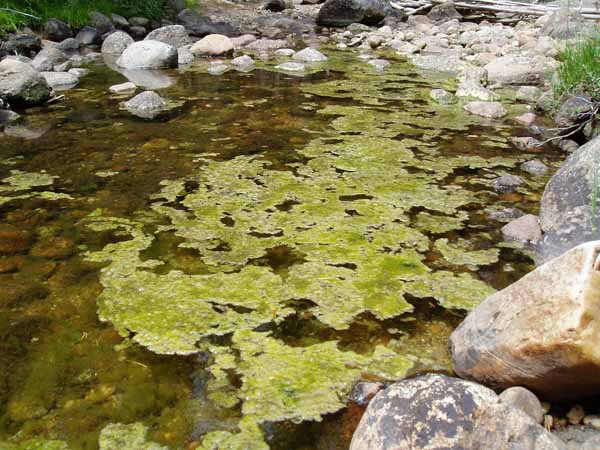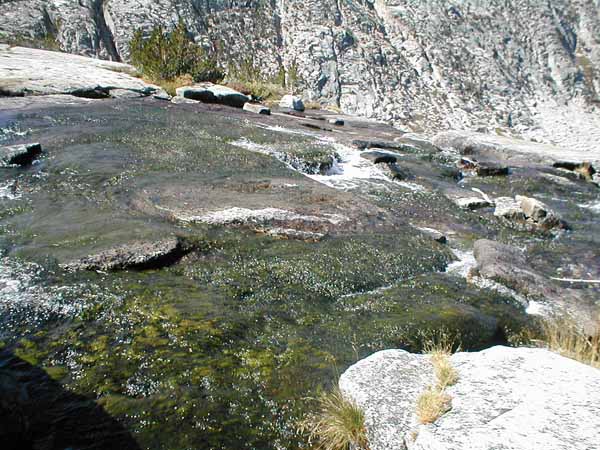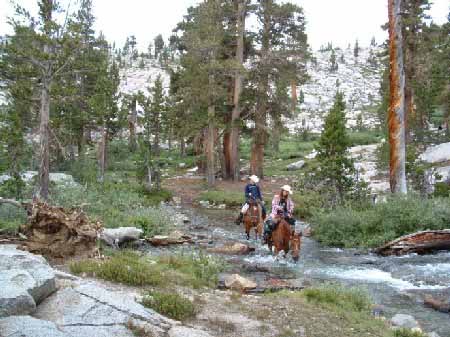Sierra Nature Notes, Volume 9, February 2010
Algae
in the Sierra Nevada Wilderness areas
Robert W. Derlet, M.D.1
Kemal Ali Ger, Ph.D.2
University of California, Davis
1,2John Muir Institute of the Environment
1 School of Medicine
2 Dept of Environmental Science and Policy
Address for reprints:
Robert W. Derlet, M.D.
University of California, Davis
4150 V Street, PSSB Suite 2100
Sacramento, CA 95817
Phone: (916) 734-8249
Fax: (916) 734-7950
Email: rwderlet@ucdavis.edu
 |
Algal growth in what should be a pristine mountain stream in Yosemite
National Park |
Introduction:
Prior to the 1850’s water in the Lakes and Streams of the High Sierra
Nevada mountains were clean and clear. Lake Tahoe had exceptionally brilliant
waters, with visibility exceeding 100 feet. Early Visitors to high country
lakes and streams above 6,000 ft elevation marveled at the clarity of the
water. However, much has changed over the past 150 years in the sensitive
habitats/wilderness of the high Sierra. Development such as roads, urbanization,
forestry, and mining also brought large scale changes in land use, pollutants,
and hydrology, resulting in significant and widespread deterioration of water
quality. The clear relationship between development and subsequent
decline in water quality in developed areas such as Lake Tahoe have been
discussed, regulated, and litigated for years. Less attention has been paid
to the wilderness and road-less areas of the Sierra, where most people assume
and expect that water quality remains of pristine quality. Unfortunately,
water quality has deteriorated in once pristine watersheds, and like Lake
Tahoe, increasing algae in these wilderness areas is the telltale sign.
Increasing Algae in the wilderness: Eutrophication
Globally, concern has been raised about serious threats to the planet’s
drinking water supply from eutrophication of watersheds (Conley 2009). One
of the best markers of water quality is the amount of algae growing in the
water; both suspended, and attached or so called benthic vegetation. As
far back as the 1880’s the detrimental effect of algae on alpine water
quality was noted and cited as one of the reasons to establish Yosemite National
Park in 1890 (Farhqur 1965). Visible algae in many High Sierra lakes and
streams have clearly increased over the past 20 years. Increased algal
growth is a global management issue, causing multiple problems including
reduced water clarity and the emergence of “pea soup” colored
lakes, oxygen depletion, declines in drinking water supply/increased cost
of drinking water purification, and in more extreme cases resulting in blooms
of toxic algae, fish kills, and clogging of waterways with water weeds (Horne
1994). All of these symptoms require costly solutions, yet can be prevented
by simple land use practices and watershed management.
Eutrophication is the scientific term that describes increased algal growth caused by elevated concentrations of nutrients, especially biologically available forms of Nitrogen and Phosphorus, in lakes, rivers, and their watersheds. Algae are aquatic plant like organisms that require nutrients and sunlight to grow. When provided both, they flourish and reduce water clarity, turning it a turbid green color, or by increasing attached “weed-like” forms in shallow creeks and lakes. Eventually, increased algal matter causes several changes to the chemical and biological functions of aquatic systems. For alpine watersheds adapted to a low nutrient state, eutrophication poses a more serious threat because there are few natural filters such as large wetlands and meadows that normally absorb some of the nutrients out of the water. Indeed, the high Sierra is so nutrient limited that even traces additions of nitrogen via atmospheric deposition is enough to stimulate algal growth in lakes (Goldman 2000).
The Sierra Nevada has enormous economic importance from the provision of abundant quantities of fresh water for California. The Sierra Nevada watersheds provide roughly 50% of California’s fresh water for domestic use (Carle 2004). Most of the high elevation watershed consists of surface or near surface granite or metamorphic bedrock, with shallow topsoil and has minimal buffering capacity (Moore 2000). Since the discovery of gold in 1848, deposition of growth limiting nutrients such as phosphorus (P) and nitrogen (N) has resulted in eutrophication of much of the Sierra Nevada, with increases in phytoplankton production rate and biomass. As a result, minor amounts of environmental pollution may have a significant impact on aquatic life since there is little or no biogeochemical retention, transformation, or fixation of trace elements, neither any capacity to absorb or filter major nutrients such as nitrogen and phosphorus. Relatively small amounts of nutrient addition or habitat disturbance leads to significant impacts on nutrient flux and subsequent impacts on the aquatic ecosystems of lakes and streams.
Impact of Algae
Algae in the Sierra Nevada have adapted to the natural conditions of low
nutrient concentrations and high water clarity. These results in a unique
assemblage of phytoplankton and marsh weeds, which support an ecosystem,
composed of native insects, fish, amphibians, birds, and mammals. Increasing
nutrient loads into the water shifts the base of the ecosystem, causing
changes in the composition of algae and plants, with consequences to other
animals and water quality.
At low levels, increased rates of algal growth cause minor problems such as reduced water clarity and increased water weeds as seen in Lake Tahoe (Goldman 2000). However, even at low levels, increased algal growth indicates long term and steady trends in water quality degradation as they signal a shift in the watershed processes. If left unchecked, this shift is prone to get worse, as nutrients tend to accumulate and eutrophication has many feedback cycles, which over time, accelerate the problem. In a way, low level increases in algal growth are an early warning for highly sensitive alpine watersheds.
Lower water clarity means less sunlight for algal growth at deeper waters in lakes. Since algae produce oxygen, darker waters mean less oxygen. In other words, as more algae crowd the surface waters, there is less light and less oxygen in deeper waters. In addition to the quantity, eutrophication also changes the quality of algae. As nutrients increase, the composition of algae shift to those that are harmful or have less nutritional value. This disrupts the transfer of energy to higher animals such as fish. With most of the algae not eaten, they sink to the bottom and rot, further depleting oxygen during the slow decomposition process. The combination of reduced clarity and shifting composition of algae can create low oxygen zones causing fish kills. Algae also secrete glycolic acid, which is believed to be the major cause of foam now seen in many high Sierra lakes and streams (Goldman, 2009, personal communication).
Low oxygen also triggers a feedback in the Phosphorus cycle. In short, when oxygen concentrations drop below a threshold, sediments begin to release phosphorus into the water, increasing algal growth even more. During this well documented cycle, called internal loading, nutrients released by human activity result in unintended feedbacks causing even more nutrient release from the lake itself. Lake sediments can absorb Phosphorus in well oxygenated waters due to chemical qualities of iron, and release the Phosphorus when oxygen levels drop.
Eutrophication can act as a fertilizer to increase dominance of harmful
algae such as cyanobacteria, which produce toxins that affect humans and
animals alike, and severely degrade water quality. Increased rotting algae
can also promote bacterial growth and also provide habitat for harmful pathogens
such as E-coli, Salmonella, Campylobactor and Giardia. Human pathogens
do not survive well in pure water, however the presence of algae means that
the necessary nutriments for survival of harmful microorganisms are present
(Yers 2005). Taken together, impacts of increased and unwanted algae affect
animals and humans and can be prevented by simple management of watershed
land use practices that regulate nutrient loading into surface waters.
When high nutrient conditions coincide with warm water temperatures, toxic
cyanobacteria (blue green algae) can proliferate. Some algae produce toxins
that are harmful to aquatic organisms and humans alike (Falconer 2005). Common
toxins include microcystins, anatoxin, saxitoxin, physteria toxin, and others.
Cases of toxic algae blooms have been recorded in the Swiss Alps, another
high mountain ecosystem (Mez 1998). Microcystin toxin from algae in the Swiss
Alps has also resulted in the death of animals that drink the water, and
in deaths of cattle reported at multiple mountain locations (Mez 1997). Animals
have died in Spanish National parks after drinking water contaminated with
algae and their toxins (Lopez-Rodas Maneiro 2008). Anatoxins and Saxitoxins
have can cause seizures and death. During the summer of 2007 the California
State Health Department posted warnings along the Klamath River warning persons
not to drink, or let their pets drink the water, because of toxins secreted
from algae in the river water. Routine Algae toxin surveillance of
the Sierra Nevada waters has not yet occurred.
 |
Algal
growth as a result of unnaturally high nutrient load at Evolution
Lake, Kings Canyon National Park. |
Combined /cumulative impacts of climate change impacts and nutrient loads implies more algae and worse water quality in Sierra headwaters. Predictions for future climate in the Sierra Nevada include earlier snow melt, longer, warmer summers, which mean a longer growing period for algae as well as warmer waters, conditions that facilitate more algal growth (Coats 2006). In fact, warmer temperatures alone have increased algal growth in Lake Tahoe (Winder et al, 2008) Thus, the combined effects of nutrient loading and warmer water will most likely intensify eutrophication in the coming years for the high Sierra.
Cattle and Algae production
Summer cattle grazing on public lands disturb processes that maintain high
water quality in the watershed. Manure from grazing cattle can be washed
into both lakes and streams and also dropped directly into the water. This
type of non-point pollution introduces and also provides nutrients such
as nitrogen and phosphorus which increase algae growth causing eutrophication
of otherwise naturally nutrient poor ountain lakes and streams. It is estimated
that 40,000 head of cattle are moved to Sierra Nevada mountain areas for
summer pasturing (USDA). On average, each head of cattle excretes 50 kg
of manure and deposit in additional nitrogen containing urine into the
alpine landscape every day (Ohio State University, 2006). In contrast,
healthy human waste amounts to less than 0.15 kg/day. Therefore each head
of cattle produces over 300 times as much wastes as a human in a single
day. So each summer the 40,000 cattle in the high Sierra produce amounts
of untreated sewage equivalent of 12 million people. In contrast, using
trail quotas, it is estimated that no more than 20,000 human visitors are
in roadless areas of the Sierra on an average summer night. The disproportionate
impact by cattle becomes obvious when the data is compared this way. Such
use of mountain range grazing in the Sierra predates the establishment
of the National Forests in 1906, but currently is regulated through the
granting of summer grazing permits by the U. S. Forest Service. The Forest
Service charges livestock operators about $4.05 per cow for the summer
grazing.
Cattle manure contains high amounts of both N and P compounds, and 100 head of cattle will deposit 500 kg of P and 400 kg of N each day on the range (Ohio State University 2006). Thus, fecal matter from cattle with P and N as well as other nutrients has contributed substantially to the eutrophication process, and in roadless areas are the major and most significant source of P, N, and trace elements. In addition, this has promoted conditions which increase bacteria, other microorganisms, and the frequency of noxious algal blooms (Conley et al. 2009, Yers et al. 2005). Non-point pollution from cattle waste poses a serious eutrophication threat to both surface and ground water sources at both higher and lower elevations. This promotes imbalance in the ecosystems with accelerated eutrophication through fertilization of algae favoring the undesirable cyanobacteria at the expense of the more desirable diatoms and green algae in downstream lakes and rivers (Horne 1994).
In addition to increasing eutrophication, cattle change the physical habitat
of sensitive mountain meadows and creeks, destroying riparian vegetation,
promoting increased stream bank erosion, and reducing the natural filtering
qualities of shallow marshlands and meadows. The loss of physical and biological
filters in sensitive headwaters further facilitates the delivery of nutrients
added by cattle.
Pack Animals
Pack animals include horses, mules, and in some cases lamas. Similar to cattle
they excrete significant amounts of nitrogen and phosphorus containing
manure, along with trace elements. Although National Parks work hard to regulate
and limit the concentration and impact of pack animals, some areas of the
Sierra have excessive numbers which damage the watershed, such as in the
Bear Creek watershed of the John Muir wilderness, or in Emigrant wilderness
above Kennedy Meadows trailhead. Each pack animal provides the equivalent
to 100- 150 times what humans contribute in terms of algae stimulating waste
material (Ohio State University 2006).
 |
Horses in alpine stream, central Sierra. |
Humans
Humans have only small amounts of waste that is left in the watershed compared
to cattle and pack animals. In addition, nearly all human waste is buried,
thus much of the phosphorus is fixed by the bacteria and fungi within the
ground, and never reaches the waterways. However humans do wash themselves
or dishes with soap and other cleaning agents directly in streams and lakes,
even though it is illegal in National Parks and wilderness areas. This
contributes in a small, yet cumulative deposition of rate limiting substances
including zinc, phosphorus, and dissolved carbon.
Wildlife
Wildlife in the Sierra has been present for thousands of years. They are
part of the natural ecosystem, and despite their presence the High Sierra
has remained oligotrophic. Their current impact on water and ecosystem
changes is minimal.
Air Pollution
Air pollution has been observed to contribute to algae biomass in certain
regions of the world. Some of the nitrogen loading of Lake Tahoe has been
documented to occur from nitrate compounds blown into the Tahoe basin from
the Central Valley (Goldman 2000).The southern Sierra has been subject
to increasing levels of air pollution. In addition particles from as far
away as Asia have been detected in California. It is possible that substances
from air have contributed to the algae problem in the Sierra.
Steps to decrease Sierra Nevada algae growth:
References
Carle D. 2004. Introduction to water in California. University of California
press, Berkeley, CA. 1-32 pp.
Coats, R., Perez-Losada, J., Schladow, G., Richards, R., and Goldman, C. 2006. The warming of Lake Tahoe. Journal of Climatic Change;76:121-148.
Conley D.J., Paerl H.W., Howarth R.W. et al. 2009. Controlling Eutrophication:
Nitrogen and Phosphorus. Science 323: 1014-1015.
Falconer I.R, and Humpage A.R. 2005. Health risk assessment of cyanobacterial
(blue-green algae) toxins in drinking water. Int J Environ Res Public Health.
2:43-50.
Farquhar F.P. 1965. History of the Sierra Nevada. University of California Press, Berkeley;201-215
Goldman, C. R. 2000. Four decades of change in two sub Alpine lakes. Verh. Internat. Verein. Limnol.;27:7-26.
Horne, A. and
Goldman, C. 1994. Streams and rivers. In: Limnology.
2nd ed. New York: NY: McGraw-Hill:356-383.
Lopez-Rodas
Maneiro E, Lanzarot MP, et al. 2008.Mass wildlife mortality due to cyanobacteria in
the Donana National Park in Spain. Vet record 162;317-323.
Mez K., Beattie K., Codd G.A., et al. 1997. Identification of a Microcystin benthic cyanobacteria linked to cattle deaths on alpine pastures in Switzerland. Eur. J. Phycol. 32:111-117.
Mez K., Habselmann K and Preisig H. R. 1998. Environmental conditions in high mountain lakes containing toxic benthic cyanobacteria. Hydrobiologia 368:1-15.
Moore, J. G. 2000. Exploring the highest Sierra. Stanford University Press. 1-86 pp.
Ohio State University. 2006. Ohio livestock manure management guide. Bulletin 604-06:1-9.Ohio State University, Columbus, Ohio.
USDA National
Agricultural Statistics Service. 2007. Livestock County Estimates California.
Winder M, Reuter J.E., Schladow S.G. 2008. Lake warming favors small sized
planktonic diatom species. Proc R Soc B: doi:10.1098/rspb.2008.1200 published
online.
Yers, H. L., Cabrera, M. L., Matthews, M. K., et al. 2005. Phosphorus, sediment and Escherichia
Further Reading
Reducing
the impact of summer cattle grazing on water quality in the Sierra
Nevada Mountains of California: a proposal
Journal of Water and Health In Press, Uncorrected Proof © IWA
Publishing 2009 | doi:10.2166/wh.2009.171
Robert W. Derlet,
Charles Goldman and Michael J. Connor
Water
quality and the grazing animal
R. K. Hubbard*,2,
G. L. Newton and
G. M. Hill
and
G. M. Hill
* Southeast Watershed Research Laboratory, USDA-ARS, Tifton, GA 31793 and
and  Department
of Animal and Dairy Science, University of Georgia, Tifton 31793
Department
of Animal and Dairy Science, University of Georgia, Tifton 31793
INVESTIGATOR'S ANNUAL REPORT
National Park ServiceYosemite Packstock and Microbial Water Quality Project,
Principal Investigator:
Mr Edward Atwill
2001, 2002, 2003,
2004
Our Founder Questions? Go to About Our New Site |
Masthead
Photo from: |